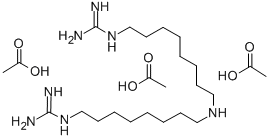IMINOCTADINE TRIACETATE
- CAS NO.:39202-40-9
- Empirical Formula: C24H53N7O6
- Molecular Weight: 535.72
- MDL number: MFCD01724078
- EINECS: 254-351-1
- SAFETY DATA SHEET (SDS)
- Update Date: 2023-05-09 09:30:53

What is IMINOCTADINE TRIACETATE?
The Uses of IMINOCTADINE TRIACETATE
Iminoctadine triacetate is used as a seed treatment or spray for control of Septoriu nodorum, Tilletia caries, Fusarium spp. and Helminthosporium spp. in cereals. It is also used on citrus fruit and apples.
Definition
ChEBI: Iminoctadine acetate is a polymer.
Metabolic pathway
Iminoctadine is a strong base with two guanidino groups with pKa >13 and an amino group with pKa >9. It is ionised at all pH values typically encountered in the environment. Although the tri-cation is highly polar it will be strongly sorbed to soils by the ion exchange mechanism as well as by hydrophobic interactions of its alkyl chains. Amino compounds usually readily form unextractable residues in soils. For these reasons the fungicide is strongly sorbed to soils and there it has low biological availability to plants and animals and is protected from microbial degradation. The only major identified products of transformation were products of photooxidation and the deamidinated products detected in rats.
Degradation
Iminoctadine triacetate is stable in neutral and aqueous acidic media but unstable in alkaline conditions. There was no appreciable hydroysis of iminoctadine in buffer solutions at pH 5,7 and 9 after one month at 25 °C (PM). [14C-guanidine]Iminoctadinetr iacetate was coated onto glass plates and exposed to artificial (12 hours day-1) or natural sunlight. Loss by volatilisation was negligible over 336 hours. Photodegradation was initially rapid (DT50 40 hours) but subsequently slowed (DT50 912 hours). One major and several minor photoproducts were detected after irradiation for 336 hours and in total represented 69% of the applied radioactivity of which the major product accounted for 31%. The major metabolite was converted into pyrimidine derivatives to aid analysis by IR, NMR and MS methods. The major photoproduct was tentatively identified as 4- or 6-methyl-5-oxo-9-azaheptadecane-1,17-diguanidine (2 or 3, Scheme 1) and it was formed by photo-oxidation and methylation of adjacent methylene groups. One of the intermediates in the formation of 2 or 3 was another unidentified photo-oxidation product of iminoctadine (Sato et al., 1985b).
Properties of IMINOCTADINE TRIACETATE
| vapor pressure | <0.4 x 10-3 Pa (23 °C) |
| storage temp. | 0-6°C
|
| Water Solubility | 764,000 mg l-1 (25 °C) |
| pka | >9, >13, >13 (strong base) |
Safety information for IMINOCTADINE TRIACETATE
Computed Descriptors for IMINOCTADINE TRIACETATE
New Products
Tert-butyl bis(2-chloroethyl)carbamate 4-Methylphenylacetic acid N-Boc-D-alaninol N-BOC-D/L-ALANINOL N-octanoyl benzotriazole 3-Morpholino-1-(4-nitrophenyl)-5,6-dihydropyridin- 2(1H)-one Furan-2,5-Dicarboxylic Acid DIETHYL AMINOMALONATE HYDROCHLORIDE 1,1’-CARBONYLDIIMIDAZOLE R-2-BENZYLOXY PROPIONIC ACID 1,1’-CARBONYLDI (1,2-4 TRIAZOLE) N-METHYL INDAZOLE-3-CARBOXYLIC ACID (2-Hydroxyphenyl)acetonitrile 4-Bromopyrazole 5-BROMO-2CYANO PYRIDINE 5,6-Dimethoxyindanone 5-broMo-2-chloro-N-cyclopentylpyriMidin-4-aMine 2-(Cyanocyclohexyl)acetic acid 4-methoxy-3,5-dinitropyridine 1-(4-(aminomethyl)benzyl)urea hydrochloride 2-aminopropyl benzoate hydrochloride diethyl 2-(2-((tertbutoxycarbonyl)amino) ethyl)malonate tert-butyl 4- (ureidomethyl)benzylcarbamate Ethyl-2-chloro((4-methoxyphenyl)hydrazono)acetateRelated products of tetrahydrofuran




You may like
-
 2033-24-1 98%View Details
2033-24-1 98%View Details
2033-24-1 -
 1975-50-4 98%View Details
1975-50-4 98%View Details
1975-50-4 -
 2-HYDROXY BENZYL ALCOHOL 98%View Details
2-HYDROXY BENZYL ALCOHOL 98%View Details
90-01-7 -
 2-Chloro-1,3-Bis(Dimethylamino)Trimethinium Hexafluorophosphate 221615-75-4 98%View Details
2-Chloro-1,3-Bis(Dimethylamino)Trimethinium Hexafluorophosphate 221615-75-4 98%View Details
221615-75-4 -
 61397-56-6 CIS BROMO BENZOATE 98%View Details
61397-56-6 CIS BROMO BENZOATE 98%View Details
61397-56-6 -
 14714-50-2 (2-Hydroxyphenyl)acetonitrile 98+View Details
14714-50-2 (2-Hydroxyphenyl)acetonitrile 98+View Details
14714-50-2 -
 118753-70-1 98+View Details
118753-70-1 98+View Details
118753-70-1 -
 733039-20-8 5-broMo-2-chloro-N-cyclopentylpyriMidin-4-aMine 98+View Details
733039-20-8 5-broMo-2-chloro-N-cyclopentylpyriMidin-4-aMine 98+View Details
733039-20-8